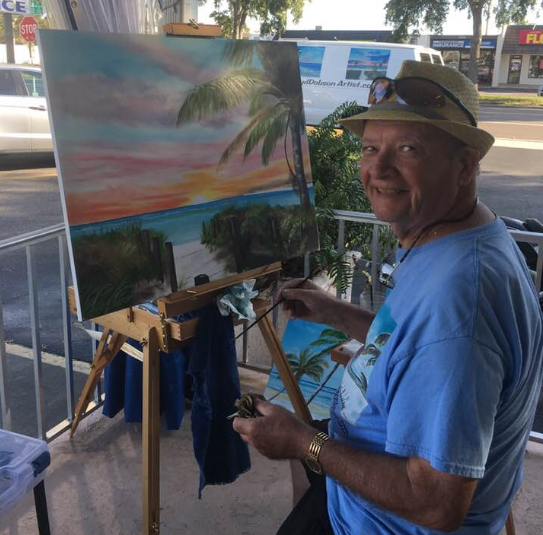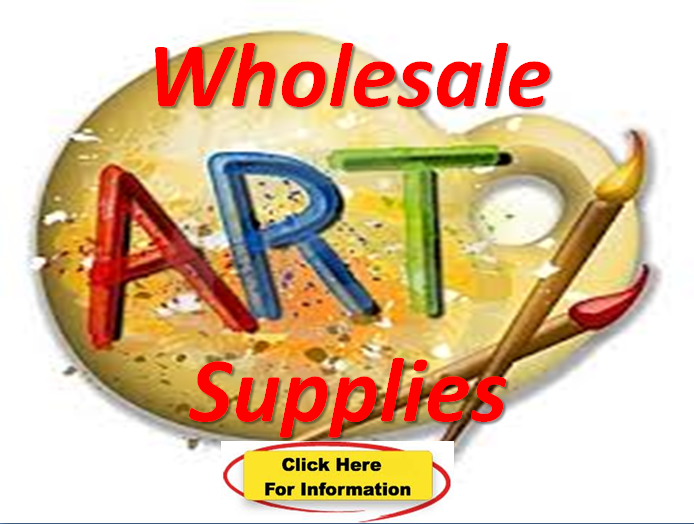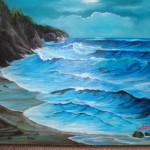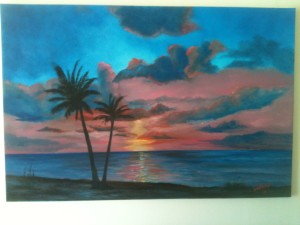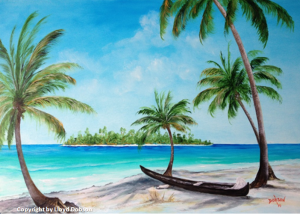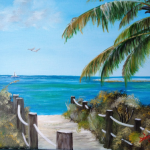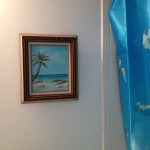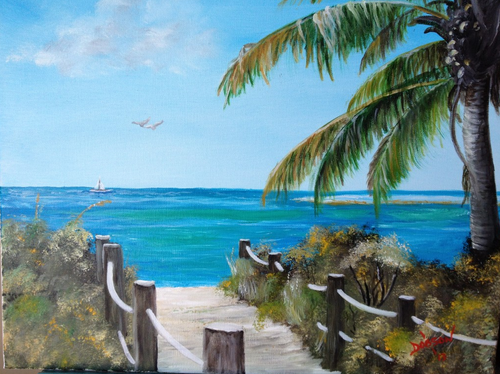Author: Lloyd Dobson
Why Buy From Siesta Key Florida Artist?
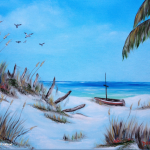
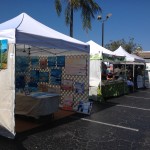 Why Buy From Siesta Key Florida Artist? Well for a couple of great reasons: For love and money! Just because you can’t afford an original Monet or Picasso doesn’t mean you have to settle for bare walls or cheap reproductions. Local art is affordable, and you may be surprised by the wealth of talent that exists in your own city.
Why Buy From Siesta Key Florida Artist? Well for a couple of great reasons: For love and money! Just because you can’t afford an original Monet or Picasso doesn’t mean you have to settle for bare walls or cheap reproductions. Local art is affordable, and you may be surprised by the wealth of talent that exists in your own city.
On Siesta Key, Florida it is a Sunday morning tradition since 2008 from 8am to 2pm, the Siesta Key Farmers Market offers a wide variety of fresh fruits and vegetables, fine art by artist Vanessa Simonard and Lloyd Dobson, Jamaican prepared foods and pastries, hot breakfast, organic green tea, local plants, Italian olive oils, artisan breads, organic skin care products, clothing, jewelry, photography, pottery, and live music.
If you need a bit of encouragement, here are six reasons to “buy local”:
1) Original works are alive

16×20 BUY $175 – #15714 – Free Shipping US Only
by Lloyd Dobson
Direct from the artist’s hand, an original painting or sculpture may be more expensive than a copy, but it’s alive with the artist’s spirit and vision! Nothing mass produced by an anonymous person or machine can come close to the sense of vitality that emanates from an original work of art.
Why fill your home with machine-made kitsch when you can own original and affordable works of art created by respected local artists? If your budget is tight, you can ask the artist or gallery about leasing work, paying by layaway, or buying sketches rather than a fully finished work.
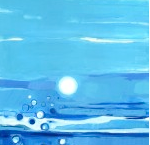
20×24 BUY $680
by Vanessa Simonard
2) Meet the artist
It’s rare that we ever get to meet the people who create the products we buy and use daily. Buying local—from food to wine to art—is popular for a range of economic and social reasons. When you buy from local artists, you can learn their backgrounds, follow their careers, and even arrange a studio visit to see where and how the magic happens. Sure, buying local helps the local economy, but more important, it builds relationships that can last a lifetime.
3) Choose your scene

16×20 BUY $175
#15814 – Free Shipping US Only
by Lloyd Dobson
Local artists often paint familiar scenes, capturing the beauty and uniqueness of neighborhoods, farms, and local rivers, lakes and mountains. Artists also accept commission work. If there’s a scene that holds particular fascination for you, or that relates to your life in a special way, ask a local artist to capture it on canvas.
4) Enhance your well-being
Like meditation and yoga, art can be a relaxing and spiritual force in your life, whether you practice it or simple look at it. Surrounding yourself with local art that is unique and meaningful provides a sense of comfort you can’t find in commercially manufactured products.
5) Become a collector
Have you ever collected coins or stamps? Most avid collectors are attracted by the beauty and rarity of these treasures. Original art work is unique—one of a kind. You’ll never walk into someone else’s home and see your art on their walls. True collectors buy art for love, not money. They take pleasure in being surrounded by beauty, knowing that there is special meaning in the art they have personally chosen or commissioned.

16×20 BUY $175
# 15614 – Free Shipping US Only
by Lloyd Dobson
Since much local art is affordable and collectable, whether you collect by artist, genre, medium or style, you’re likely to find what you want right in your own backyard. If you’d like to start collecting art but aren’t sure how to judge “good” art from “bad” art, contact an art consultant or take a class to build your confidence. But remember, even the critics and historians don’t always agree on what’s good or bad art. Buy a piece of art because you love it, and let your own sensibility and intuition be the best guides.
6) Art as an investment
If you agree with Andy Warhol that “Making money is art and working is art and good business is the best art,” then you’re likely to focus on the investment potential of art. There’s no denying that some forms of art have become a commodity whose prices are dictated by dealers, auctions and market forces. The national and international art markets are generally geared toward works whose prices can range into the millions, whereas local art market prices usually run from $100 to $5000.
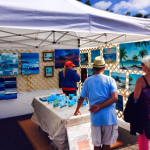
But, even if you believe that art should be primarily about investment, you can still benefit from buying local. Many local artists are early- to mid-career artists, which means their work is still affordable and will likely increase in value as their artistic skills mature. You have the advantage of buying these early works, and watching the artist’s reputation—and your investment—grow.
For additional information concerning artist Vanessa Simonard and Lloyd Dobson you may visit the following websites:
http://www.LloydDobsonArtist.com
http://www.SiestaKeyBlueWave.com
We also invite you to come by and see us every Sunday from 8:00am to 2:00pm at the Siesta Key Farmers Market located in the Siesta Key Village,
Best Online Wholesale Art Supplies
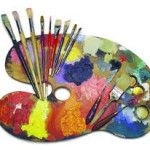

Best Online Wholesale Art Supplies are necessary, if you have a budget, want quality artwork and want the ability to save money on your supplies. Can you really save money buying your supplies online? Well all I can do is give you my uncensored review on the subject. This is Lloyd Dobson artist sharing this information with you. Why am I writing this review. Well it is very simple. When researching the subject of saving money on all those supplies I purchase from a brick and mortar businesses, there were very few reviews written.
Whether you are feeling the crunch of the current economic climate or not, saving money is just good common since. Many people dismiss the online sites as dealers in inferior quality or practitioners of dubious ways. This is not true and it is proved that many online deals result in good quality and worthwhile bargains.
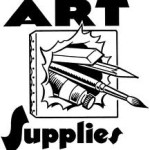
Online art stores provide a convenient alternative to brick-and-mortar shops for artists and hobbyists who need to replenish their stock of staple and specialized art supplies. Art supply stores online provide thousands of affordable art supplies for a wide range of art genres and styles.
Hobbyists and professional artists can find all kinds of creative supplies online – from studio staples to hard-to-find items. It’s so convenient to stock up on art supplies for your next project from the comfort of your own living room.
What Makes a Top-Notch Art Supply Store?
A vast assortment of art supplies is a hallmark of any outstanding online art store, but it should also provide features and services that enhance the overall shopping experience. The best art supply stores rank high in the following four criteria:
Product Selection: An art store’s offerings should extend far beyond general art supplies, catering to all types of creative outlets. In addition to specialized items such as crafting and printmaking supplies, top online art supply stores also sell studio furniture, professional equipment and portfolios.
Site Features: To help artists hone their skills and promote art education, the best online art stores provide beneficial site features such as art tutorials, online forums and product demos. They also provide school discounts, course supply wish lists and other useful resources for art educators.
Shipping Options: Multiple shipping options provide flexibility, while order tracking and free shipping offers provide the assurance that ordered supplies will be received when needed without breaking the bank.
Help & Support: While browsing an online art store, customers may periodically have a product inquiry or need assistance to complete their order. Top-notch art supply stores provide direct assistance via telephone and email, as well as online FAQs and return and exchange information that customers can reference while shopping.
The best online art supply stores cater to all types of artists, with a massive product selection that includes both general art supplies and unique, one-of-a-kind items. Informative site features can broaden an artist’s knowledge and skill set, while exceptional customer service and versatile shipping makes shopping online for art supplies convenient and simple.
For additional information on Best Online Wholesale Art Supplies
Additional Resources : The Best Art Supplies …at the best discounts! Since 1911, artists have turned to this art materials company for their Wholesale Art Supplies for dependable savings, a huge selection, and fine customer service on art supplies.
Original Art For Sale On eBay


 Original Art For Sale On eBay is one of the biggest market places on the Internet. There are millions of items being sold there everyday. As an artist you may be wondering how to sell original art on eBay and make money or even a living from it. If you are an artist looking to sell your art in as many places as possible then you have probably thought of trying to sell art on eBay.
Original Art For Sale On eBay is one of the biggest market places on the Internet. There are millions of items being sold there everyday. As an artist you may be wondering how to sell original art on eBay and make money or even a living from it. If you are an artist looking to sell your art in as many places as possible then you have probably thought of trying to sell art on eBay.
There are many things that are the same as selling offline. But many are different. Unlike the offline world, a potential buyer does not get to see your work in person. They do not see you in person. But that doesn’t mean that selling art online is harder. In some ways it is easier.
An art purchase is a very emotional buy. It is almost at the same level as buying a house or a car. Of course the potential buyer has to feel an emotional attachment to the piece if they are going to purchase it- this is not the place to create that. If a buyer is emotionally attached enough to the piece to buy it and then receives something that was not exactly as expected- your buyer will be unhappy and probably ask for their money back.
If not I guarantee they will not be buying any additional art pieces from you. You can’t risk this because someone who collects art is just that- a collector. Future purchases are highly probable. Make sure they know exactly what to expect.
Be completely descriptive about your art for sale. Make sure that you have stated all of the important information about the piece. Give the art buyer as much information as possible about the piece. This will reduce the amount of questions and help qualify the potential buyer.
These small but important facts will do a lot of the selling for you. Make sure to include price, medium, size, type of paper/ canvas, framed/ unframed, subject matter, and date. Don’t forget to include; your motivation for choosing this subject
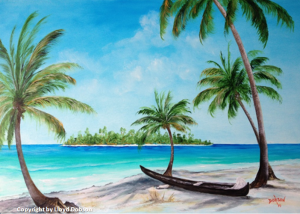
matter, what it means to you, challenges when working on your art, and why you have chosen to express these ideas in this manner. This is where you create an emotional attachment. An art buyer becomes attached as they begin to feel they understand the piece and the artist behind it.
eBay is the most well known auction site in the world. On eBay, you can sell your framed and polished works at the price of your choice. You have the option of allowing buyers to bid on your work or buy it out at a set price.
So the first thing you need to do is to check out the competition. Find out what is selling on eBay by checking the sold listings, look at what prices paintings are selling for in your particular niche.
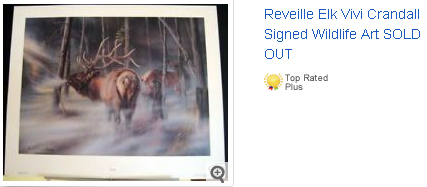
When you have checked out the competition and you know what kind of prices you can sell your work for you then need to come up with a good title and description for your listing. Make sure you include any positive selling points for your painting/artwork so that these are exploited to the full. For example if the painting is an original and one of a kind make the buyer fully aware of this and the fact that no-one else will have a duplicate of this painting.
Next thing you need to make sure of is that you have a great photograph of the artwork. It should be an accurate representation but should show it off in the best light. A good thing would be to have a picture of the artwork, for example above a sofa or a bed but in a setting that is suited to the painting.

Selling art on eBay is only one way of selling art online, there are several others. Learn How To Sell Art Online and get resources on how to market and promote your art by clicking the link. On my website there are additional marketing ideas for you. Plus if you want to buy your art supplies from 50% to 70% off retail there is a place for you on the site as well. Go to Lloyd Dobson Artist now.
Original Paintings For Sale



Original Paintings For Sale by Artist Lloyd Dobson can be found on Siesta Key every Sunday or in his studio. Lloyd’s love of God’s beautiful seascapes and landscapes inspire his paintings which start many times with on location watercolor sketches or photos and then back to the studio to capture God’s beauty.
Why not join the Collector’s Circle? How will you celebrate your wedding anniversary, magically? How can you mark a big birthday, unforgettably? How can you thank your best client, remarkably? The answer is an experience of art.
An experience of art is an everlasting and meaningful gift; one that you know that the recipient has yet to receive. This extraordinary gift celebrates shared treasured moments, artfully. When experiencing this you will be savoring the moment in vibrant artist colors.
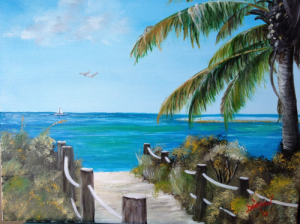
Imagine choosing your favorite landscape, the place holding your heart’s most meaningful memories. Then visiting that special place with recognized artist Lloyd Dobson.
Join the creative journey with Lloyd as he brings God’s palette to his studio to explore the colors of the vista by painting in oils on canvas the experience. Week by week Lloyd unfolds the inspiration and creative process on canvas.
Now is the time to gather a circle of friends and family for an inspired celebration. Host an unveiling where your painting will be revealed.
Lloyd was born in Kansas City, Missouri and raised in Independence, Missouri. Studied art at William Chrisman High School and Central Missouri State College winning several art awards. While in Missouri he studied under the direction of artist Andrew Thoman. In the early 60’s he migrated to Southern California where he continued studying under the artist Bert Carter.
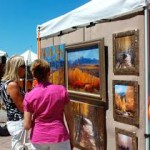
He participated in 100’s of art shows throughout Southern California and eventually partnered with three other artist opening gallery in Laguna Beach, California. In the mid 60’s he opened a gallery, studio and art supply store in Canoga Park, California, where he also taught oil painting. Hundreds of oil paintings ranging from seascapes, landscapes and still life hang in hundreds of private collections throughout the United States.
In 2007 he moved to Siesta Key – Sarasota, Florida area where his paintings seem to be influenced by this beach area as well as his travels through the years. You can find Lloyd every Sunday at the Siesta Key Market located in the Siesta Key Village on Ocean Boulevard.
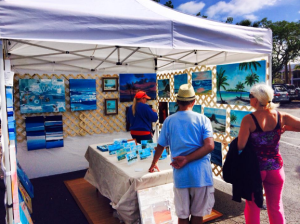
For additional information and a fine art gallery of his oil paintings, please visit his website at: www.LloydDobsonArtist.com
To reserve your Experience of Art Please e-mail Lloyd Dobson directly a photo of a landscape or seascape memory you wish to capture on canvas at: LloydDobsonArtist@gmail.com, or phone (727) 362-8628 Kindly leave a message. All calls will be returned within 24 to 48 hours.
Art For Sale On Siesta Key Review



Art For Sale On Siesta Key Review does not yield much information when typed into a search engines. Especially concerning local artist. This is what someone pointed out to me recently. When they searched for a particular local artist, nothing came up. Through the Siesta Key BlueWave website, I am committed to inform you about the Key’s artistic events.
This is my uncensored review on the subject and it is my intent to share the availability of Siesta Key art for sale. Before we review two local artist, let me share with you that art is not totally absent on the Key. There are two large fair events with traveling artist displaying their artwork, however finding local artist like the Siesta Key BlueWave artist Vanessa and Lloyd in the group tends to be lacking in the large venues.
The two annual art and craft fair events are held in February and again the end of April. There are over 250+ artist who line up on Ocean Boulevard with their professional display booths. They display their unique and affordable crafts throughout Siesta Key Village.
All artists and craft people were present for the duration of both shows, available to discuss their work and inspiration. The event appeals to people of all ages including serious art buyers looking to add to their collections. With a wide variety of art mediums on display and prices ranging from $25 hand-designed earrings to $30,000 metal sculptures, there was something for everyone.
In addition to the couple of events through the year You can visit the Siesta Key Farmers Market every Sunday from 8:00am to 2:00pm. There you will find representation of local
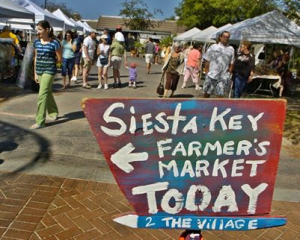
crafts as well as fine artist Lloyd Dobson and Vanessa Simonard. Siesta Key art for sale now becomes available for those seeking local artist.
Early 2014 Lloyd and Vanessa, neighbors near Siesta Key, decided to put their skills at work to the common effort of promoting Siesta Key’s cultural spirit as well as its natural habitat. Their vision is to make it very easy for everybody to find out what’s going on the Key. Siesta Key BlueWave seeks to create a stronger sense of community for those who cherish this island and all that she offers.
Art For Sale On Siesta Key by Vanessa and Lloyd is inspired by the beauty of Siesta Key and through their sales donate to the environmental charity organizations to help maintain the beauty and preservation of this island paradise.
You can find out more by visiting http://www.SiestaKeyBlueWave.com
How Many Paintings Are Needed For Your Art Show?
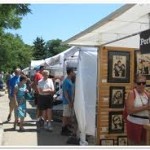
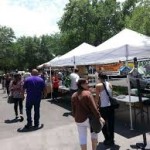

How Many Paintings Are Needed For Your Art Show? This a question that is predicated on the space that you will have available. Most outdoor art events spaces are limited between 10’x10′ and 10’x20′ spaces. The larger meaning you would register for two areas adjacent to each other.
My suggestion would be to have three different sizes of your art work. Large, medium and small as an example. With different sizes you are able to accomplish a couple of things. One is an exhibit that is more appealing and secondly allowing you to have several price points. A good rule of thumb would be between 20 to 30 pieces per 10’x10′ space. Another factor will be determined by the time you have to create the work needed.
study your exhibit space carefully and take pictures and measure the space. Make a scale drawing either on paper or computer of the wall/exhibit space (I’m assuming for flat work) and use “to scale” shrunk down cutouts or paste ups of your work and then start playing around with the layout of what you will hang. You may be limited in the number of pieces just by available space alone. Also, will you have access to track lighting, ambient light only and so on.
If you don’t have enough art work of your own, a great idea is to share your booth space with another artist that complements your work, as well as your art work with theirs. My experience has shown me that when colaborating with a partner you become twice as smart and that results in great marketing strategies to help both you and your partner’s success in your art show.
If you are passionate about your art and enjoy sharring your creative talents with the world, you will figure out a way to create enough art inventory for your art exhibits. So now back to the question, how many paintings are needed for your art show? The answer as you can see varies from show to show and the area you will have available.
Is Your Art Good Enough For An Art Show?



Is Your Art Good Enough For An Art Show? Lets defines terms here. By ‘good’ in terms of an art show meaning interesting, engaging and that ultimately someone would be willing to transfer money from their bank account to yours to own it.
What’s the perennial question that a good half of all artists face?
It’s not a lack of inspiration, or the money to sustain oneself. From our survey, It seems that its simply – How do I get noticed?
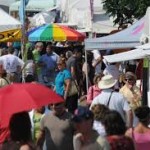
I have always had the mindset that, if I wanted something bad enough, as long as it didn’t defy God’s Law that I had the capabilities to accomplish the situation. Even though we are creative, sometimes we must come out of our cozy self-created wonderland and ask the question “Is my art any good?”
On the internet, you will find an overwhelming range of quality in art, everything from random pencil doodles scribbled on lined notebook paper to the most highly polished, professional artwork that exists. Since the range of quality is so massive, there really is no “standard” whatsoever for what should be shown publicly. What it really boils down to is what your motivations are for showing your art. If you are looking to work professionally, my answer would be to get over it and get your work out there immediately. If you’re making art for yourself, then go with your instinct and do what you are most comfortable with.
 When you finally do make the decision to show your work to the world, you have to brace yourself for the wave of comments that occurs and be ready to handle it. Showing your art can be both incredibly rewarding and difficult at the same time. Every time you show your artwork publicly, it is like walking the plank. Putting your work out there is a big risk every time. I have had people say lovely, moving things to me about my work. I have also had people make brutal, insensitive, comments.
When you finally do make the decision to show your work to the world, you have to brace yourself for the wave of comments that occurs and be ready to handle it. Showing your art can be both incredibly rewarding and difficult at the same time. Every time you show your artwork publicly, it is like walking the plank. Putting your work out there is a big risk every time. I have had people say lovely, moving things to me about my work. I have also had people make brutal, insensitive, comments.
I had a professor in graduate school who came up to me in person, completely unsolicited, one day and said to me ”I am very disturbed by what you do,” and then went on to describe in great detail what a terrible artist I was. I was so completely startled by his comments that I was left speechless. Fortunately I did not let that get me off course from my dreams, goals and accomplishments.
Are people really interested in your art? Do people stop and stare when they pass your art?
It is all relative of course. If you are a beginner artist then your art may not have reached it’s full potential yet, but there has to be a certain something about your art no matter what level of experience you have that makes people stop, look and get interested if you want to have any chance of success with your own art show.
Related Article: How To Sponsor Your Own Art Show
Art Pricing – What Should I Price My Art?

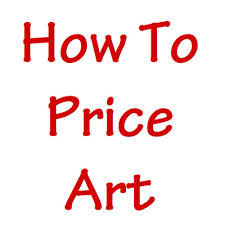 Art Pricing – What Should I Price My Art? This is a question that I am ask many times. In order to price your art realistically, you must understand and respect how the art business works and how collectors shop and buy. You must also objectively assess your art world accomplishments and determine how they position you in relation to all other artists. These are difficult tasks and not necessarily pleasant; but they’re absolutely essential to achieving the goals of making a go of it as an artist and of selling art.
Art Pricing – What Should I Price My Art? This is a question that I am ask many times. In order to price your art realistically, you must understand and respect how the art business works and how collectors shop and buy. You must also objectively assess your art world accomplishments and determine how they position you in relation to all other artists. These are difficult tasks and not necessarily pleasant; but they’re absolutely essential to achieving the goals of making a go of it as an artist and of selling art.
Understanding common mistakes that artists make when setting prices is the first step in this process. Perhaps the most significant error is the tendency to focus too much attention on only that segment of the art world that pertains to you and too little attention on the rest, or even worse, dismissing the rest as irrelevant. If you let this happen, your asking prices may make sense to you and to your inner circle, but make little sense to the overall art community.
Many artists make the mistake of equating dollar values with psychological factors like how emotionally attached they are to their art or how much angst they experience during the creative process. They place special meanings and, therefore, special asking prices on certain pieces of their work that may make sense to them inwardly, but have little or no relation to the selling prices of the rest of their art or to art prices in general. Dealers and collectors see these prices as inconsistent or excessively high.
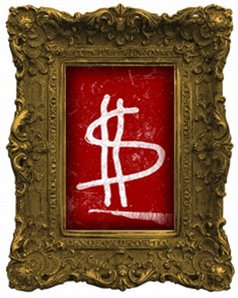
Don’t make the mistake of thinking that your art is so unique that nothing else compares to it. All art is unique. Every artist is unique. Uniqueness, however, has never been and never will be the sole criterion for setting prices at any particular level.
Collectors rarely see themselves as having only one choice when selecting art, no matter how “unique” that art happens to be. Not only are they cost-conscious, but they almost always compare work from artist to artist and gallery to gallery before they buy. The more comparing they do, the better they get at collecting, assessing quality, determining fairness in selling prices, and getting the best bangs for their bucks. This is what good collecting is all about and what you’re up against when it comes to pricing your art.
Here is a typical question: “I am thinking of having prints made of some of my watercolor paintings and selling them on sites like Etsy. I’m not sure how to go about having prints made, as far as making it profitable. Any suggestions?”
This is a great question. Pricing is really tough, but you can figure it out! Here are a few things to consider:
 1) Costs – You need to make back what you spent in making the art. This can include fixed costs like your office space, lighting, heating, etc. These costs must be spread out among the number of pieces you plan to sell on a monthly basis. For example, if your studio and rent together cost $1000 per month, and you plan on selling 10 prints per month, then you have $100 in costs for each print, before you ever count anything else. If you think you can sell 20 prints each month, then it’s only $50 per print.
1) Costs – You need to make back what you spent in making the art. This can include fixed costs like your office space, lighting, heating, etc. These costs must be spread out among the number of pieces you plan to sell on a monthly basis. For example, if your studio and rent together cost $1000 per month, and you plan on selling 10 prints per month, then you have $100 in costs for each print, before you ever count anything else. If you think you can sell 20 prints each month, then it’s only $50 per print.
Then there are your costs per painting, or variable costs. This includes your canvas, brushes, the paint you used, and the time you spent (yes, your time is a cost, unless you are working for free) and the cost of the prints. These will vary based on how much paint you use, how big the canvas is, etc. These will be calculated on an individual painting basis.
How much is your time worth? How much do you want to make? If you make $20 per hour, that’s about $40,000 per year. (Hint: You’re worth more than that.)
2) Goals – What are your painting goals? Are you trying to appear like you care what the art world thinks, or are you creating art for your buyers?
 Also, how much money to you want to make? If your basic cost per painting is $50 for fixed costs plus $20 for materials, then you add the 10 hours that it took you to paint the piece, then that’s another $200. How many prints do you want to sell before you make that back? 20 prints? That’s $90 per print. (Then you sell the original for gobs of money.)
Also, how much money to you want to make? If your basic cost per painting is $50 for fixed costs plus $20 for materials, then you add the 10 hours that it took you to paint the piece, then that’s another $200. How many prints do you want to sell before you make that back? 20 prints? That’s $90 per print. (Then you sell the original for gobs of money.)
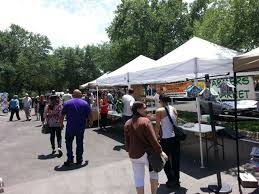 3) Research – After you know your costs and goals, find out how much it costs to buy other artists’ work. Not just any artists, but look at artists who work in similar styles to you. Look at watercolors that are for sale on Etsy and see what the high, middle, and low prices are. Where do your paintings fit in? Is your work more like the high end or low end of the pricing structure?
3) Research – After you know your costs and goals, find out how much it costs to buy other artists’ work. Not just any artists, but look at artists who work in similar styles to you. Look at watercolors that are for sale on Etsy and see what the high, middle, and low prices are. Where do your paintings fit in? Is your work more like the high end or low end of the pricing structure?
4) Test – Pricing is as much of an art as it is a science. There’s no right or wrong way to do it, as long as you are making money. Price out a few pieces at a few different levels and see which ones sell the most or which ones end up being the most profitable.
Remember that today’s collectors are more sophisticated than ever. The idea of falling in love with one piece of art and having to have it at any cost fell by the wayside years ago. Collectors now research and compare before they buy. The only ones who don’t are new to the game. Just in case you get lucky and find one who’s a little naive, by the way, resist the temptation to take advantage and overcharge. You risk the possibility of turning them off to continued collecting. We all know that we need all the art collectors we can get.
Lastly, have something for everyone. Offer art in all price ranges. People who like your work, but can’t afford the big stuff should at least have the opportunity to come away with something. These are your biggest fans, your collector base, the people who will stand by you throughout your career. Do whatever you can to provide them with art. That’s the best way to maximize your exposure, create good will, get yourself out there, jump start your sales, and become known and respected in the arts community.
WHOLESALE ART SUPPLIES AS HIGH AS 70% OFF RETAIL – CLICK ON BANNER BELOW AND COMPARE PRICES
